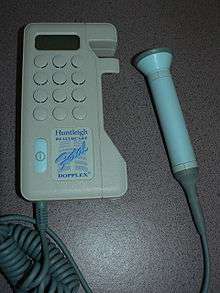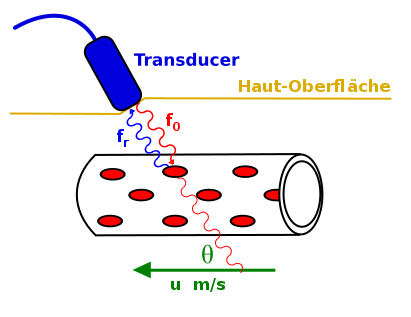Doppler fetal monitor
Doppler fetal monitor or Baby Heartbeat Monitors is a handheld ultrasound baby heartbeat monitor used to hear an embryo or fetus' heartbeat.
Originally intended for use by health care professionals, despite this, Fetal Doppler devices have become extremely popular for personal use.
History
Invented in 1958 by Dr. Edward H. Hon,[1] a Fetal Doppler Monitors or Baby Heartbeat Monitors is a hand-held ultrasound transducer used to detect the fetal heartbeat for prenatal care. It uses the Doppler effect to provide an audible simulation of the heart beat. Some models also display the heart rate in beats per minute (BPM). Use of this monitor is sometimes known as Doppler auscultation. Doppler fetal monitors are commonly referred to simply as "Dopplers" or "Fetal Dopplers".
Doppler fetal monitors provide information about the fetus similar to that provided by a fetal stethoscope. One advantage of the Doppler fetal monitor over a (purely acoustic) fetal stethoscope is the electronic audio output, which allows people other than the user to hear the heartbeat. One disadvantage is the greater complexity and cost and the lower reliability of an electronic device.
 |
Recording From a Fetal Doppler Monitor
Recording from a consumer grade fetal doppler monitor of a ~16 week fetus. |
| Problems playing this file? See media help. | |
Originally intended for use by health care professionals, this device is becoming popular for personal use.


Fetal Heart Rates
Starting at week 5 the fetal heart rate accelerates by 3.3 bpm per day for the next month.
The fetal heart begins to beat at approximately the same rate as the mother's, which is typically 80 to 85 bpm. The approximate fetal heart rate for weeks 5 to 9 (assuming a starting rate of 80):
- Week 5 starts at 80 and ends at 103 bpm
- Week 6 starts at 103 and ends at 126 bpm
- Week 7 starts at 126 and ends at 149 bpm
- Week 8 starts at 149 and ends at 172 bpm
- At week 9 the fetal heartbeat tends to beat within a range of 155 to 195 bpm.
At this point, the fetal heart rate begins to decrease, and generally falls within the range of 120 to 160 bpm by week 12.[2]
Types
Dopplers for home or hospital use differ in the following ways:
- Manufacturer: popular manufacturers are Newman Medical, Nicolet (purchased by Natus), Arjo-Huntleigh, and Summit Doppler (now Cooper Surgical).
- Probe Type: waterproof or not. Waterproof probes are used for water births.
- Probe Frequency: 2-MHz or 3-MHz probes. Most practitioners can find the heart rate with either probe. A 3-MHz probe is recommended to detect a heart rate in early pregnancy (8–10 weeks gestation). A 2-MHz probe is recommended for pregnant women who are overweight. Newer 5-MHz transvaginal probes aids in the detection of fetal heart tones (FHT) early in pregnancy (6–8 weeks) and for patients who have a retroverted uterus or throughout pregnancy for FHT detection for women who are obese.
- Heart Rate Display: some Dopplers automatically display the heart rate on a built-in LCD; for others the fetal heart rate must be counted and timed by the practitioner.
- Smartphone Fetal Dopplers were first developed in 2014.[3] These devices use a cable linked to smartphone with a downloaded app to allow users to monitor the baby's heartbeat. Although potentially intended for domestic use, some clinicians are exploring the potential of this technology for home telemetry.
A major advantage of being able to record and share the recording is that it can be emailed to a healthcare professional to be checked if there are any concerns about whether or not it is the baby's heart rate and whether or not is normal. Typically, they work from about 12 weeks.
The use of the word "Sonicaid" for Doppler fetal monitors comes from the products of the UK company Sonicaid Ltd. Sonicaid products included the D205/206 portable fetal Dopplers and FM2/3/4 series of fetal monitors. The company was acquired by Oxford Instruments in 1987 to form Oxford Sonicaid.
Doppler Auscultation in Adults
It was recently demonstrated that continuous Doppler enables the auscultation of valvular movements and blood flow sounds that are undetected during cardiac examination with a stethoscope in adults. The Doppler auscultation presented a sensitivity of 84% for the detection of aortic regurgitations while classic stethoscope auscultation presented a sensitivity of 58%. Moreover, Doppler auscultation was superior in the detection of impaired ventricular relaxation Since the physics of Doppler auscultation and classic auscultation are different, it has been suggested that both methods could complement each other.[4][5]
See also
References
- ↑ Roger K. Freeman, Thomas J. Garite, Michael P. Nageotte, Fetal Heart Rate Monitoring Third Edition, 2003, p. 3. "The earliest preliminary report of FHR monitoring came in 1958 from Edward Hon, MD,... via fetal ECG monitor on the maternal abdomen." Google Books citation
- ↑ FetalSure. Fetal Heart and Heartbeat Facts. Available at http://www.fetalsure.com/fetal-heart.html. Retrieved 9 August 2010.
- ↑ "Listen to your baby's heartbeat - on your SMARTPHONE: New app allows mums to track their baby's progress". Daily Mail. Retrieved 4 May 2014.
- ↑ Mc Loughlin MJ, Mc Loughlin S (2012). "Cardiac auscultation: Preliminary findings of a pilot study using continuous Wave Doppler and comparison with classic auscultation". Int J Cardiol. 167: 590–591. doi:10.1016/j.ijcard.2012.09.223.
- ↑ Auscultación Cardíaca Normal Con Estetoscopio Doppler Continuo: Un nuevo método 200 años después de Laennec (Spanish Edition) http://www.amazon.com/s/ref=nb_sb_noss?url=search-alias%3Daps&field-keywords=mc%20loughlin%20santiago